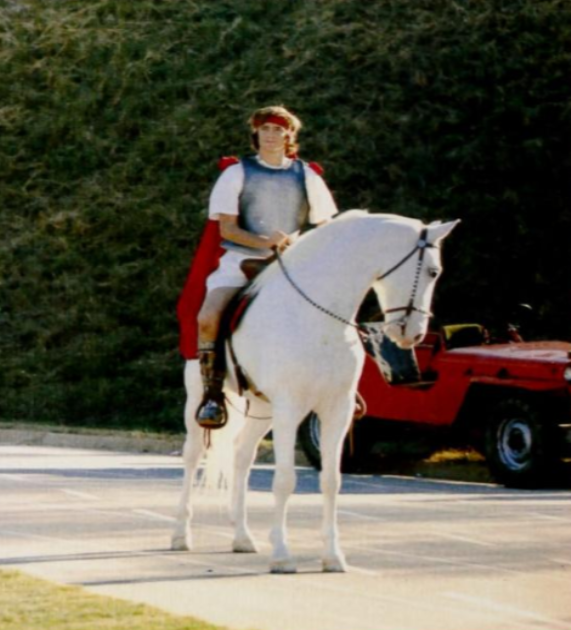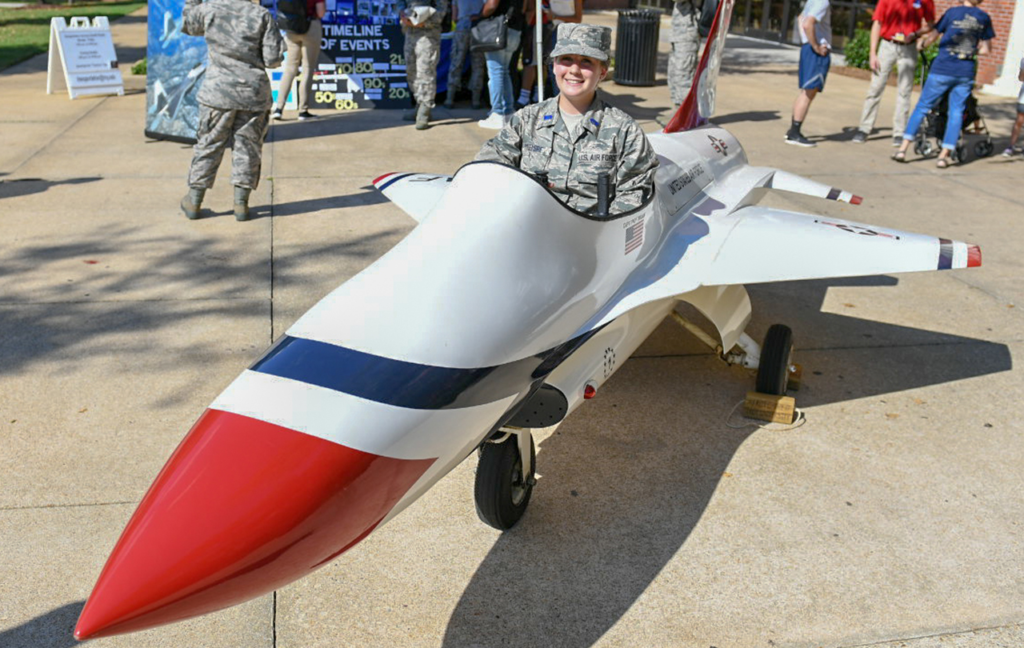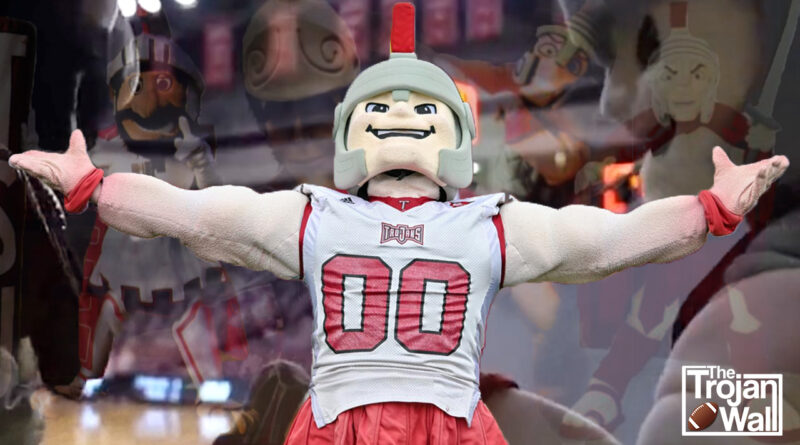The Complete and True History of T-Roy, Part 1
One of the most enduring memories for many fans of sports teams is the mascot that roams the stands and sidelines during gameday. Whether high school, college, or professional, the mascot is an interactive symbol for the team.
While earlier examples exist, the modern push for college mascots started in the 1980s, with many universities making the mascot a part of the cheerleading squad. It is in this period that one of America’s greatest mascots was created—T-Roy.
To understand his story, we must go back to the beginning of Troy Athletics.
Humble Beginnings
From 1909 to 1930, Troy teams went by many nicknames. They were the Trojans, Teachers, Normalites, and, though I have found no contemporary evidence, Bulldogs, according to many Troy sources.
Between inconsistency of team names and Troy’s lack of funding, creating and purchasing a mascot was not something that would be feasible for many of Troy’s early years.
In 1931, Albert Elmore solidified the Troy identity by mimicking the University of Alabama. Instead of the Crimson Tide, Troy would be the Red Wave.
The biggest problem with the Red Wave as a moniker is that it’s extremely hard to actually dress up like a wave. Just look at Tulane’s attempt to make its iconic Green Wave logo a three-dimensional entity in 1964. (This actually remained for 20 years until they switched to Poseidon himself. Maybe that’s the reason Troy and Tulane have a little beef.)

In lieu of a mascot, someone created Troy’s version of the Angry Wave, a logo I will call T-Wave. This logo, as far as I can tell, was only used on cheerleader megaphones.
Based on images in Palladiums, it was in use from 1968 or 1969 until 1972, going out of use when Tom Jones arrived in 1973.


Since this logo was only used by cheerleaders, it never seemed to stick for other Athletics teams. Unfortunately for T-Wave, the tide was turning on the Red Wave.
Even after reaching the highest of highs with the football National Championship in 1968, the students of the early 1970s did not connect with the amorphous moniker. At the beginning of Jones’ first football season, students held a vote to determine the new name of Troy State’s Athletics teams for the future.
On September 7, 1973, the student body held a vote, after a committee of faculty, staff, and members of the Student Government Association made a recommendation to make name, mascot, and color changes.
As the legend goes, the Troy State football team left to play ULM that Friday, but the results didn’t come in till Saturday morning, hours before kickoff. The vote was overwhelmingly in favor of the Trojans moniker, with 1,471 students approving the change and only 570 against it.
The team took the field with its new name, and the Trojans tied ULM 15-15.

This is where things get interesting. To most, when you think of a mascot, you typically think of a costumed figure with a large head and a large body (unless you’re Kansas State).
Troy State could’ve went with one of these mascots as they weren’t unusual at the time. In fact, our chief rival at the time had been using a large chicken mascot since at least the mid-1960s.
However, the powers that be had other plans and 1973 would be a great year for horses in Troy.

Non-T-Roy Mascots
As a history teacher I often lament the use of Greek soldiers in place of Trojan ones, particularly in gifs from the 2004 movie, Troy. I know it is pedantic, but it’s kind of my thing.
That being said, imagine my surprise when I found this.

Yes, Troy did in fact used to have a 15 foot tall, 12 foot long Trojan Horse statue named “Trojan Stud.”
A Trojan horse.
You know, like the ones the Greeks left for Troy and then used to destroy the city.
See my problem with not knowing the Iliad?
A much bigger concern is the length of time Troy used it. Even its introduction is shrouded in mystery.
This photo is from a Nov. 15, 1973 article in The Dothan Eagle explaining the new mascot. But I can’t find any evidence that it was actually used at a Troy game, since the regular season finale of 1973 was five days prior.
I couldn’t find any other mentions or photos of “Trojan Stud” in newspapers of the time or in Palladiums either. Potentially, there could be photos or more stories in the Troy Messenger from 1973, but their online archives only run through 1963.

However and whenever it was used, “Trojan Stud” was pretty amazing for the time. The 15×12 structure was set on wagon wheels so it could be easily moved around The Vet, as well as in parades, and could apparently fit all 10 cheerleaders comfortably.
TS was built of weatherproof plywood and was painted white with a silver mane and tail. His saddle blanket was painted red and TSU was painted in black. This seamlessly meshed the new color palette for Troy together for all to see.
The original idea was conceived by Assistant Professor Chet Meisner of the Speech and Theatre Department. It was adapted and built under the watchful eye of the master carpenter of Troy’s Physical Plant Department, Horace Killingsworth.
Its head could turn to each side and the tail could also move. It could also breathe fire.

Okay, maybe not fire, but fire extinguisher powder. Red fire extinguisher powder!
This was done by placing the red powder and attaching it to a trigger that would make “Trojan Stud” spray the red “flames” every time the Trojans scored. It would’ve certainly been quite a sight to see the red smoke spewing forth from the nostrils of “Trojan Stud” after an exciting touchdown.
Also debuting in 1973 was a much more widely known and used symbol for Troy, the Trojan Warrior/Prince/Princess.
The original Trojan Warrior was Tod Clemmons of Okeechobee, Florida. The first horse was a beautiful white stallion provided by Mr. John Wilson of New Hope, Alabama.

The first official outing for Trojan Warrior was October 20, just in time for Homecoming 1973. Maybe it’s just me, but the glaring issue with this early version is that his colors are red and gold, evoking images of Romans, which were kind of Trojans (Thanks, Aeneas), or worse, USC.
Starting in 1974, the gold helmet would be removed in favor of a red headband, which would quell the Roman/USC connections.

The Trojan Warrior would go through many different iterations and would be Troy’s second longest-serving mascot. An indelible part of the gameday experience at The Vet, the Trojan Warrior would race out onto the field leading the team at the beginning of the game.
Unfortunately, the growth of Troy as a university led to the death of this beloved tradition. The renovations to facilitate the Trojans’ move to Division I-A (now FBS) meant that the stadium had to be renovated to expand the seating to 30,000 fans.
However, with modernity comes change.


Rather than continuing to use a grass field, Troy chose to switch to an artificial “field turf”, which under normal use was guaranteed to last ten years. Unfortunately, this caused concerns about the animal and rider’s safety, so the Trojan Warrior/Princess was no more once the natural grass was torn out after the 2002 season.
There is one more previously-maligned, now beloved part of Troy history that we must talk about: the Touchdown Jet, or Trojan Force One as it was more formally known.

Modeled after the Air Force’s famous Thunderbirds, Trojan Force One was a mainstay of post-touchdown celebrations at The Vet during the mid-2000s into the 2010s. I couldn’t find any specific dates, so that vague guess will have to do.

Trojan Force One was operated by Troy’s Air Force Reserve Officer Training Corps, Detachment 017. The group is designed to identify officer candidates for both the Air Force and the Space Force.

After touchdowns, one officer would drive Trojan Force One out onto the field and hype up the crowd to keep them in the game. Many at the time (myself included) thought the Touchdown Jet was a rather cheesy addition to the gameday experience.
That actually says a lot considering we were firmly in the “I Like to Move It” era. Now though, the nostalgia hits and we think back to something unique and fun that used to be a present part of gameday at The Vet.
Let’s not also forget about Pete the Gopher from 1981, who predated T-Roy.

The Mascot, The Myth, The Legend

While these other attempts at unifying the fanbase have their special times in Troy history and memories associated with them, none carry the cache of the face of Troy Athletics: T-Roy. The mascot has been an ever-present stalwart of the Athletics experience, appearing at football, basketball, and baseball games.
Though T-Roy is an important part of Troy’s history, most Trojans don’t know the full scope of the most well-known face of Troy.
The names of the teams changed in 1973, but the creation of a mascot took over ten years to become something more than an idea. It wasn’t until Homecoming 1984 that T-Roy made his grand appearance for the first time to the Trojan Faithful.
November 3, 1984 would be a banner day in the Wiregrass.

The creation of T-Roy was truly a group effort throughout the entire Troy community. The costume was donated to the school by the Alumni Association.
Students submitted potential names for the new mascot, which were narrowed down to five choices by the TSU Cheerleading Squad. A vote was then held to decide which of those five names would be the new mascot moniker.
“T-Roy” was submitted by Angie Overstreet of Chi Omega. For her place in Troy history, she received $100 (nearly $300 in 2024).

The new mascot made his grand appearance at Homecoming 1984 in a chariot being pulled by a Trojan football player on a four-wheeler. #54 is his number, but I’m pretty sure this wasn’t a player, judging by the sweat pants.

This early version of T-Roy looked more like the mascot for one of Troy’s rivals in the 1980s, the Central Florida Golden Knights. Everything worked for this first iteration of T-Roy, but the metal gloves, metal helmet with a slotted visor and metal breastplate and shin guards definitely give off 1300 AD more than 1300 BC.

Time appropriateness aside, much like Trojan Stud did a decade before, he perfectly integrated all of Troy’s school colors into his attire.

But who was the first T-Roy? The man behind the mascot, as it were.
According to the 1986 Palladium, the first performer to don the T-Roy costume was Alexander City native Andrew Henderson. He had previously been the mascot at his high school, Benjamin High, and took to portraying T-Roy naturally.

The first major update to T-Roy came in 1987. The majority of the costume was unchanged, but several small details were added or altered.
Most obviously, the red T was gone, replaced with a much larger black T. Trojans script was written diagonally in red across the T. The black line on the shin guards was changed to red and the blocky tassles on the cape were gone as well.

Additionally (and based off the small amount of evidence I have to go off of), 1987 was the first year that T-Roy was portrayed by a female Trojan student. Trojan Ambassador and member of the TSU Forensics Team, Muffy Edelberg was given the task of bringing Alabama’s best mascot to life.

1989-1990 would see yet another change to T-Roy, but this time a much more subtle one. Gone now was the red script Trojans across his chest. The T was also much smaller and more of a block T.

Mark Hunt and Paul Elliott began portraying T-Roy in what seems to be the first reference to a two-person split of time in the costume in the 1991-92 year.

Confusingly, the Palladium has two different photos of T-Roy from this year. One saw the return of the Trojans script, though this might be an old photo.

The other photo shows T-Roy at a parade for the first time wearing a cheerleading uniform. In the coming years, T-Roy would begin to dress for the occasion depending on the sport being played.


The “Cheerleader” T-Roy would continue from the 1991-92 school year until some weird stuff happens in 1994.
The Palladium mentions that the cheerleaders were taking him to the Fountain of Youth, though where in The Vet that was, I’m not sure. Peculiarly, this is the first time that T-Roy was depicted in a suit jacket and pants. It must’ve been for the ceremony.

Whatever did happen in the ceremony was not for the faint of heart. The grizzled, bearded look of our Trojan Knight was gone and replaced by…..this.


I truly have no words.
Because there are only two photos that I can find of this version of T-Roy, I would have normally passed it off as just something a fan or student was wearing in the crowd.
But since the Palladium makes direct reference to this being the new T-Roy, I have to make assumptions about this change.
Until someone corrects me, I have to assume that the old costume, which was a decade old at that time, was placed in to the “Fountain of Youth” as a way to introduce the new T-Roy without it being a sudden, abrupt change. Considering this looked like a caricature of Tommy Trojan from USC, even down to the gold helmet, it is understandable that the change would be confusing to say the least.
Much like New Coke, however, the mistake was quickly rectified in 1995 with the return of Bearded T-Roy. If anyone can give me more insight into “New T-Roy” and what the full story is on him, please contact me on Facebook, Twitter, or in the comments below.
While the head of the mascot would remain unchanged, the rest of the costume received a massive overhaul. For the first time, T-Roy began wearing a football jersey, a tradition that continues to this day.
He was also given a new skirt, and based on a later picture, the plume on the helmet would be changed to black.

Photos were not available for the 1996-97 year, but they had plenty in 1997-98. These offer a better look at the new body of the costume, but unfortunately, they abandoned the jersey for a plain breastplate. His leg guards were also changed to match the new costume and look a little less like silver shin guards.


The role of T-Roy was given to Brian Puckett in 1998-99, though the costume did not have any major changes.

In 1999-2000, T-Roy seemed to bring a bit of the classic look by sewing the block T on the chest plate of his armor. It was very similar to the block T from the first iteration of the costume. T-Roy also traded in the boots for sandals again.

One thing that definitely needs to come back for T-Roy is the T-Roy Kart, or Cheer Kart as the sticker says. This would be a lot of fun for parades and Trojan Walk, though I know it probably wouldn’t be possible with the turf.


I found a very interesting tidbit from the 2000-01 Palladium that I wasn’t expecting.
Normally, T-Roy was listed with the cheerleaders, which makes sense. He does represent the Trojan Spirit the cheerleaders are often trying to bolster.
This year, T-Roy actually posed with the Majorettes, the Dance Team, and the Tubas in the Sound of the South. Not exactly sure why this was the case, but these are the things you find when you research a mascot.



By this point, you have probably been able to get the image of New T-Roy out of your mind. So, here’s a palette cleanser. 2001-02 Clean-Shaven Facemask T-Roy?

Back to the normal one.

The 2001-02 year saw no real change in the costume, though this is the first year a full-color photo was printed in the Palladium.

Though there were no new changes in 2002-03, I couldn’t help but include T-Roy’s foray into high fashion and haute couture.


A few years of the status quo made T-Roy an icon and a mainstay of Troy athletics and university life. That said, even the status quo was about to change dramatically.
The year T-Roy turned 20, he wasn’t the only one growing up. A new University called for a new mascot.

Not that one, though 2004-05 SGA President Ryan Spry did a great job in his stead at a pep rally in The Vet.
This one.

And his name wasn’t T-Roy.
Click HERE for Part 2.


Pingback: The Complete and True History of T-Roy, Part 2 – The Trojan Wall